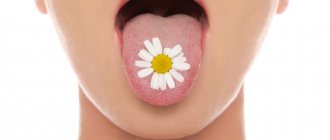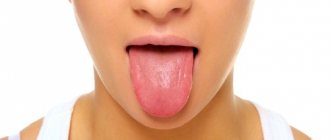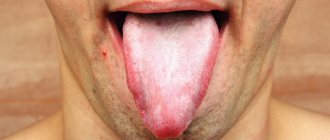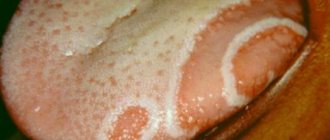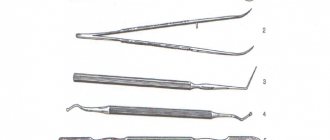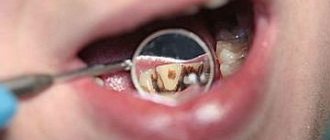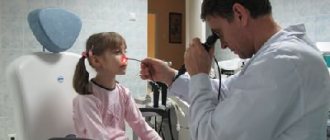Reasons for language changes
Basically, obvious changes in the language indicate the presence of a particular disease in a person. Independent tongue pathologies are much less common.
Its color may change at high temperatures. Also, the causes of damage can be injuries to the tongue as a result of biting, burns, or wearing braces.
Glossitis
Glossitis
is an inflammation of the tissues of the tongue, manifested in its soreness, changes in color and structure, and the appearance of a dense coating. There is a burning sensation, hyperemia (overflow of blood vessels), food loses its taste, and salivation increases.
If the doctor has diagnosed the patient with glossitis, then the next step is to find out whether this indicates a pathology of other organs. This could be a herpes virus, poisoning with heavy metal salts, etc. Treatment is prescribed depending on the initiating cause, trying to exclude it. It usually includes local antiseptic therapy.
What diseases does this symptom occur in?
The most popular pathology of the tongue is a change in its color. Depending on what shade the tongue takes on, you can determine the disease that caused it:
- A red tongue can indicate severe infectious diseases, as well as impaired renal function;
- The crimson color of the tongue is associated with anemia, scarlet fever;
- Pallor of the tongue is also related to anemia, as well as severe exhaustion;
- A yellow tongue is a symptom of excess bile in the gallbladder or problems with the liver;
- A blue tint is almost always a sign of cardiovascular problems;
- The dark purple color of the tongue indicates heart failure, ischemia or bleeding disorders, as well as cerebrovascular accidents;
- The black color of the tongue can be a sign of dehydration, severe disorders of the gastrointestinal tract, liver, pancreas, gall bladder, cholera;
- Green color indicates stagnation of bile;
- A brown tongue is associated with kidney disease;
- A blue tongue indicates intestinal diseases.
A popular change in the tongue is the appearance of plaque. It can occur with the following problems:
- infectious diseases;
- problems with the functioning of the gastrointestinal tract.
You can determine in which organ the changes are taking place by the location of the plaque on the tongue and its nature:
- If there is a white coating in the center of the tongue that has a slightly grayish tint, this may indicate high acidity of gastric juice, a stomach or duodenal ulcer;
- If a white coating is accompanied by a dry tongue, this may be a sign of gastritis with low acidity of stomach juice;
- Plaque on the root of the tongue appears in intestinal diseases. Frequent constipation may also be the cause;
- Plaque along the edges of the tongue and on its root appears in kidney diseases.
Tongue color for hepatitis photo – Liver treatment
Have you been struggling with LIVER PAIN for many years without success?
Head of the Institute of Liver Diseases: “You will be amazed how easy it is to heal your liver just by taking it every day...
Read more "
Liver cirrhosis is a disease in which organ tissue is replaced, which can cause damage to the entire human body. This condition is considered incurable, therefore, if symptoms of cirrhosis are detected, you must urgently visit a doctor and begin to follow all his recommendations.
- Causes of liver cirrhosis
- Stages of liver disease
- First symptoms
- Diagnosis of the disease
- Treatment of liver cirrhosis
- Prognosis for cirrhosis
- Complications
- Preventive measures
Causes of liver cirrhosis
Most often, concomitant liver diseases lead to this disease. In particular, we are talking about hepatitis. The most dangerous is considered to be variety C, the symptoms of which are difficult to recognize in time. Infection usually occurs during blood transfusion or abdominal surgery. Also at risk are drug addicts and people with promiscuous sex lives.
Diseases directly related to blockage of the bile ducts can provoke the development of cirrhosis. If this disorder is not treated, cirrhosis will occur within 6–10 months.
Doctors remind that the main cause is excessive alcohol consumption. Due to large doses of alcohol, severe intoxication occurs, as a result of which the liver is subjected to significant stress. Some powerful drugs also have this effect. For this reason, when prescribing a number of medications, it is additionally recommended to take hepatoprotectors.
Stages of liver disease
The standard course of the disease involves passing through three stages.
- The compensated stage is characterized by mild symptoms. At this stage, almost all liver cells continue to function correctly, but liver failure gradually develops.
- The subcompensated stage is characterized by the appearance of nausea, increased fatigue and pain in the right side. This period is characterized by the development of acute liver failure. Some complications are also possible, including large-scale swelling and jaundice.
- The decompensated stage is considered very dangerous. In this case, the patient must be urgently hospitalized. In advanced situations, surgical intervention will be required.
First symptoms
At the initial stage, the patient may notice a slight increase in body temperature, loss of appetite and weakness. Also, aching pain occurs in the right hypochondrium. As the disease progresses, the patient notices other symptoms:
- bloating caused by an enlarged liver;
- jaundice, in which the color of the skin and whites of the eyes becomes yellowish;
- skin rashes that cause itching.
In some cases, symptoms from the digestive system occur. We are talking about dark urine, diarrhea and constipation. Belching and heaviness in the abdomen are also possible.
Diagnosis of the disease
First of all, the doctor must collect anamnesis. Next, there is an examination for the presence of spider veins, as well as rashes, which are often observed with cirrhosis of the liver. In addition, blood sampling for biochemistry is indicated, thanks to which it will be possible to detect the course of the pathological process. Doctors may additionally prescribe an ultrasound of the liver, computed tomography, as well as angiography and biopsy.
Treatment of liver cirrhosis
All patients are first prescribed drug therapy. We are talking about taking several groups of medications:
- hepatoprotectors;
- glucocorticoids;
- pancreatic enzymes;
- vitamins;
- antiviral drugs;
- diuretics;
- probiotics.
Naturally, not all of these medications are prescribed to every patient. Thus, antiviral medications are indicated only if the cause of liver cirrhosis is viral hepatitis. A diuretic is prescribed in the presence of severe edema.
In addition to drug treatment, a gentle diet is indicated. We are talking about table number 5. The patient should avoid eating fatty, fried and spicy foods, smoked foods and preserves. The diet should include lean boiled meat, stewed vegetables and cereals.
In some cases, surgery is indicated. So, a procedure is performed to remove the accumulated liquid. Sometimes bypass surgery is prescribed, which helps create new pathways for blood outflow. In advanced situations, the patient can only be helped by performing a donor liver transplant.
In any case, people suffering from liver cirrhosis should follow a few simple recommendations.
- You should absolutely not lift heavy things.
- If you feel tired, you need to rest.
- It is important to monitor bowel regularity. If you have problems with this, you should choose a mild laxative.
- If swelling is observed, you need to limit the amount of salt consumed.
- Every day you need to measure your abdominal volume and body weight.
- If your overall health is good and there are no disturbing symptoms, then therapeutic exercises and short walks are indicated.
- If cirrhosis worsens, pregnancy should be avoided.
Prognosis for cirrhosis
The prognosis depends on many factors. In particular, we are talking about the stage of the disease and following the doctor’s recommendations. According to many years of research, it has been found that cirrhosis is incurable. As a rule, long-term remission with periodic exacerbations is observed.
The prognosis worsens in the presence of several risk factors:
- male gender;
- elderly age;
- varicose veins of the esophagus;
- neurological complications;
- presence of hepatitis B;
- reduction in liver size.
It should be remembered that cirrhosis of the liver poses a particular danger due to its complications. The most dangerous is hepatic encephalopathy, which develops into hepatic coma. Damage to brain tissue by toxins can lead to such an unpleasant consequence. Since blood flow through the liver is impaired in patients, veins may dilate.
As cirrhosis progresses, bleeding often begins. Fatigue and severe vomiting are also possible. With reduced immunity, patients often suffer from pneumonia, as well as various infections of the genitourinary system.
Preventive measures
To avoid the development of liver cirrhosis, it is necessary to regularly see a doctor, which will help to promptly identify various liver diseases. This is especially true for hepatitis, which occurs without pronounced symptoms.
Prevention of cirrhosis is possible through proper nutrition. So, you should avoid foods that are too fatty and fried. It is better to give preference to dishes cooked in the oven or steamed. It is also important to give up bad habits, namely smoking and drinking alcohol.
Although cirrhosis of the liver is considered an incurable disease, it should not be neglected. Thanks to proper drug therapy and a balanced diet, it will be possible to stabilize the body’s condition and avoid various complications. Naturally, to do this you will have to give up bad habits.
What are the causes of yellow skin?
Since ancient times, it has been well known that the condition of the skin is an indicator of human health. Many diseases can be diagnosed with high accuracy just by looking at the patient.
Yellow skin color, the reasons why it may appear, are known and well studied.
By recognizing a dangerous symptom in time, you can begin treatment of the disease in a timely manner and minimize complications from it.
Nail color and liver disease
The color of nails and their condition can tell a lot about a patient’s liver disease. They are a kind of mirror and the dullness and pallor that the toenails and fingernails have is one of the symptoms of the pathology.
In addition to the color of the nails, you should pay attention to the white crescent located under the nail of the index finger. A decrease in its size or complete disappearance is a signal of dysfunction of the liver, pancreas and digestive system as a whole.
Failures of the digestive system affect the condition of the nails, talking about:
- insufficient full functioning of the liver;
- lack of vitamin B;
- poor absorption of iron by the body;
- impaired protein metabolism.
If grooves and long lines appear on the nails, you need to be checked for liver disease. You can see examples of such manifestations in photos of the nails of other patients suffering from liver problems.
Tongue color and liver disease
Another main indicator of the state of the body is its tongue. If a person does not have diseases, then his tongue is pink, with a relief devoid of deep cracks and grooves, and there is no plaque on it.
If the internal organs malfunction, this is immediately reflected in the color of the tongue.
The color of the tongue in liver diseases, as can be judged from the photo, becomes yellow - from barely pronounced to rich shades. Jaundice, in this case, manifests itself not only on the tongue, but also on other mucous membranes, as well as on the patient’s skin.
Raspberry tongue is a symptom of such a dangerous liver disease as cirrhosis. There is even a term “liver tongue”, in which this muscular organ acquires a red “strawberry” color or even purple.
You can see what the tongue looks like with this liver disease in the photo, and the cause of this change is developing liver failure with cirrhosis.
When such symptoms appear, in addition to the tongue, you should also take a close look at the nail plates, the characteristic changes of which, in case of liver disease, can be studied from the photo.
What is responsible for skin color
In order to understand why the skin turns yellow, it is important to know what affects its color. Generally speaking, skin color is determined by human genes and a substance such as melanin, the amount of which varies among people of different races.
However, when talking about the healthy color of the skin of children and adults, they usually mean the absence of pallor and yellowness.
In the vast majority of cases, the causes of yellowness are an excess of a pigment such as bilirubin, which is found in the blood of every person and is a breakdown product of hemoglobin.
Another reason is carotene, the same pigment found in carrots and a number of other fruits and vegetables. The symptom is typical for those people who follow carrot or apricot diets or simply abuse these products. This accumulation of carotene, when the mucous membranes are not affected, is called false jaundice.
Yellow skin in newborns
This shade does not always indicate deviations. According to statistics, more than half of babies, especially those who were premature, have increased yellowness of the skin and mucous membranes. Treatment, in the vast majority of cases, is not required, but the doctor must exclude the possibility of hemolytic disease, which occurs in 3-7 newborns per thousand and requires immediate treatment.
Liver
Hemolytic jaundice. A yellow complexion indicates that the breakdown of hemoglobin occurs very quickly, and the liver cannot cope with converting its indirect form into a direct one.
Hepatic jaundice. The appearance of a yellow complexion and skin is a consequence of liver pathology caused by hepatitis, cirrhosis and other diseases. As a result, liver cells cannot cope with the processing of bilirubin and its amount increases, giving a yellowish tint to the skin.
Biliary tract
Cholestatic jaundice - this type indicates disruption of the gallbladder and bile ducts, which occurs due to the formation of stones with subsequent blockage of the ducts or their narrowing due to the formation of a tumor.
Thyroid
A malfunction of the thyroid gland, which produces substances that break down beta-carotene, is also a direct cause of yellowness.
Other diseases
In addition to those mentioned above, there are a number of other factors that lead to yellowness of the skin.
Bloodless skin with a tinge of yellowness can be one of the symptoms of cancer. Also, the manifestation may be associated with excess cholesterol in the blood and impaired lipid metabolism.
Other causes of yellow skin include:
- changes in the body due to disruption of digestive processes;
- pathologies of the excretory system;
- failure of the endocrine system.
Lifestyle and bad habits
Any bad habit, as well as a sedentary lifestyle, negatively affects the color of the skin and its condition.
So, smoking, or rather nicotine, leads to a narrowing of the capillaries, the face becomes gray, dark circles form under the eyes, due to the fact that it does not receive enough nutrients. Premature aging begins. In addition to cigarettes, alcohol and coffee also reflect on the face. If they are consumed excessively, the body becomes dehydrated and metabolic processes are disrupted.
OUR READERS RECOMMEND!
Our readers successfully use Leviron Duo to treat the liver. Seeing how popular this product is, we decided to bring it to your attention. Read more here...
You should know that the shade of the skin may change if you engage in cosmetic procedures, in particular peeling, after which spots may form on the skin.
Which doctor should I contact?
It is possible to thoroughly determine the causes of yellowness only with a full examination, including a series of laboratory tests and instrumental examination. Therefore, at the first symptoms, you should immediately consult a doctor. The following doctors deal with these issues:
- hematologist;
- gastroenterologist;
- endocrinologist;
- infectious disease specialist
In general, you need to contact your local physician, who will give you a referral to the right specialist.
Prevention and diet
It is necessary to take care of your skin and its color from a young age. Moreover, not only by using nourishing cosmetics, although they are necessary and have great benefits, but also by following a proper diet and leading an active lifestyle in which there is no place for bad habits.
It is important to understand that not only the color of the skin should be healthy, but also the body itself, with all its systems and internal organs.
Live healthy! Diseases on the face.
Source: https://1-popecheni.ru/gepatit/tsvet-yazyka-pri-gepatite-foto/
Diagnosis for language changes
Diagnostics in this case will include the following steps:
- Analysis of complaints and anamnesis . Takes into account the nature of the changes, the time of their appearance, the disorders that accompany them and the presence of symptoms to which the patient can associate the changes that have appeared;
- Life history analysis . Chronic diseases, if any, are taken into account, hereditary diseases, bad habits, taking certain medications, contact with toxic substances;
- Physical examination . In the process, the shape of the tongue and its size, shade, presence of plaque, and surface are determined. The general condition of the patient is also taken into account;
- Scraping from the surface of the tongue and examining it . Performed when there is a risk of infectious diseases;
- Consultations with specialized medical specialists. This could be a dentist, neurologist, gastroenterologist, dermatovenerologist.
Additional research methods. They are performed in accordance with individual indicators in order to clarify the diagnosis.
These can be laboratory methods, such as urine and blood tests, as well as instrumental methods: ultrasound and fibroesophagogastroduodenoscopy.
Plaque formation and discoloration of the tongue
Such secondary symptoms develop in patients due to dysfunction of the liver and immune system. Each phase of the pathological process has its own symptoms.
During the acute period, the tongue looks bright red, and its surface becomes shiny. The papillae of the organ atrophy during this phase. Its lower part becomes yellow.
At the first stage of the icteric period, the shade of the frenulum of the organ changes. She is also turning yellow. A brown or white coating appears on the surface of the epithelium.
At the height of the pathological process, in some areas of the organ located on its upper side, the epithelium begins to peel off. With such a dystrophic change in the mucosa, the filiform papillae atrophy. In photographs illustrating this condition, the tongue may be slightly coated, and the affected areas look like spots with smooth and asymmetrical edges.
Other symptoms that may occur during infection include:
- decreased organ tone;
- the appearance of teeth marks on the sides;
- redness of the tip;
- grayish coating on the root.
With cirrhosis that develops as a result of the disease, the color of the tongue becomes bright red and purple.
Treatment
Drugs
Treatment in this case will be aimed at eliminating the disease that provoked the changes in the language. For tongue tumors, this may include radiation treatment and surgery.
For an infectious disease such as candidiasis, antifungal drugs may be prescribed.
At home
At home, you can resort to rinsing your mouth with drugs that relieve inflammation. These can be decoctions of medicinal herbs such as chamomile or calendula, as well as alkaline solutions such as soda.
You need to rinse your mouth after every meal. Rinsing is especially useful when the integrity of the lingual surface is damaged, for example, in the presence of cracks or desquamation of the epithelium.
Preventive measures
To prevent diseases that can cause changes in the tongue, you should follow these preventive measures:
- Proper diet , which includes restrictions on fatty, spicy and fried foods. A balanced diet helps prevent diseases of the digestive system;
- It is recommended to stop smoking , since it causes the death of the surface cells of the oral cavity, increases the risk of infectious diseases and deteriorates blood supply, both in the oral cavity and in the digestive organs;
- Be sure to maintain oral hygiene , which will help prevent the development of bacteria.
Diagnosis by language


